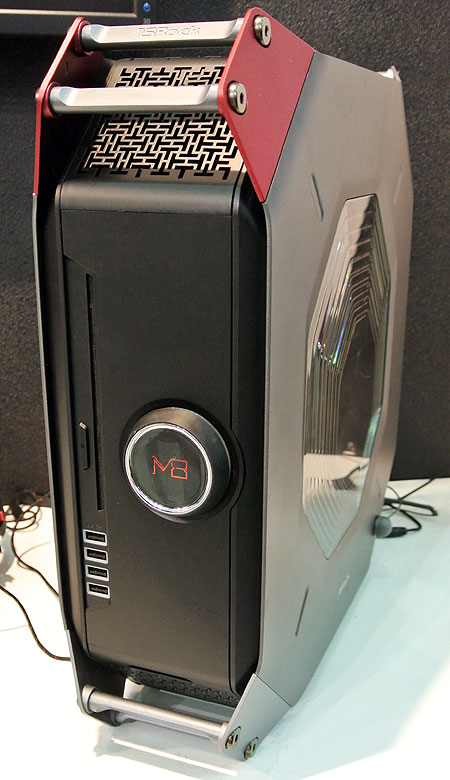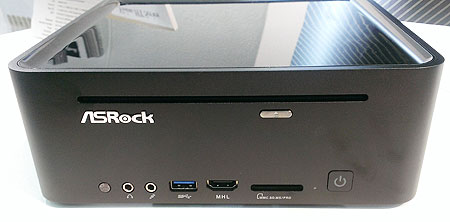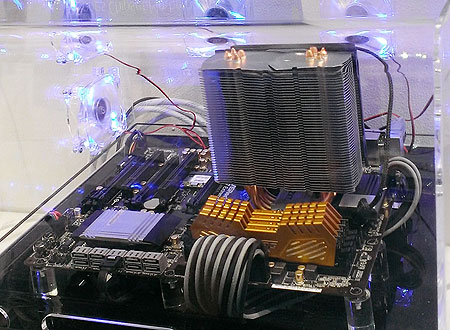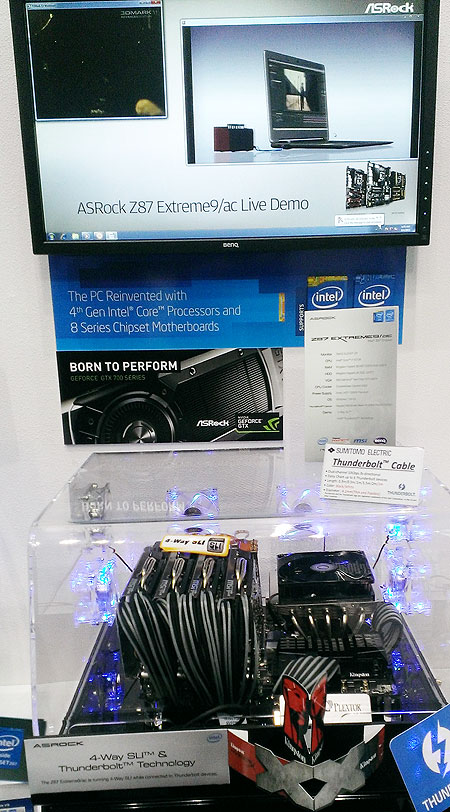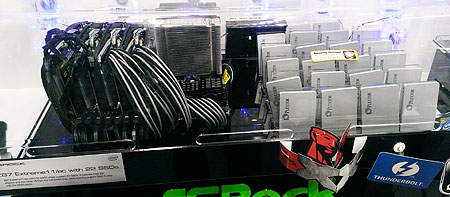Computex 2013: Motherboards, Peripherals, And Mobility
ASRock At Computex
We've looked to for innovation in the past, and the company didn't disappoint us at this year's Computex. Its upcoming M8 is an attractive barebones system with a mini-ITX motherboard, Haswell-based processor, 450 W power supply (the team claims a GeForce 680 isn't a problem), and 802.11ac wireless networking. The round LED display up front is able to display the time, CPU utilization, and more. ASRock also claims to be considering an API for more customizable control.
The chassis was developed by BMW Group DesignworksUSA, the same organization responsible for Level 10 family. Its side panels are secured magnetically; overall, it's a pretty cool little enclosure. The whole package is expected to see availability in July for $500. Could this become a more potent alternative to the next generation of consoles? Once you populate it, the M8 is going to cost quite a bit more. But you're also looking at significantly more horsepower, too.
We also saw ASRock's next generation of the Vision HT miniature HTPC. Of course it employs a mobile Haswell-based processor. More surprising to us was the addition of a new ability that lets you use the HDMI input as a pass-through for a Mobile High-Definition Link-capable phone, sending the display output to whatever monitor you connect to the Vision HT. A hotkey enables the switch when the PC is on, and the feature auto-senses when the Vision HT is off. Additionally, 802.11ac comes standard, offering throughput as high as 866 MB/s. The higher-end Vision X is expected to offer the same pass-through functionality, but with an MXM module and Radeon HD 8850M graphics. Availability is expected in July, though company representatives couldn't give us pricing details.
ASRock is pushing a feature suite it's calling A Style on its newest motherboards, including Purity Sound (leveraging Realtek’s 7.1-channel ALC1150 codec), a TI 5532 premium headset amplifier, HDMI input for sharing a monitor between devices, 802.11ac dual-band Wi-Fi, a form of waterproofing, and a feature it calls Home Cloud, allowing remote wake and control of your PC via smartphone or computer.
A little more about that waterproofing feature: this is an option for high-end overclockers who don't want to worry about condensation, mostly. The process of adding a liquid-resistant film limits production to about three boards per hour, so quantities are limited. ASRock demonstrated a Z87 OC Formula running while water was being poured on it.
ASRock splits its boards into the bottom-tier Pro, gamer-oriented Extreme, higher-end Fatal1ty, and overclocker-oriented OC Formula line-ups, each with specific capabilities and features to attract eyes in those respective segments.
The company had a lot of motherboards on display. Starting with the mini-ITX Z87E-ITX, we see six-phase power, a sextet of SATA 6Gb/s ports, mSATA support, 802.11ac wireless connectivity, and a processor interface positioned as far away as possible from the to avoid cooler interference. It also has the same HDMI pass-through functionality mentioned previously, otherwise limited to Pro4/Extreme4 boards and higher.
Get Tom's Hardware's best news and in-depth reviews, straight to your inbox.
Next is the Z87 Extreme6/ac. Also equipped with the 802.11ac Wi-Fi module, ASRock demonstrated this board driving a 4K display through Intel's on-die HD Graphics engine. It also sports the company's Purity Sound suite through the Realtek ALC1150 codec. This board currently sells for $200 on Newegg.
The Z87 Extreme9/ac will include four-way support and a Thunderbolt controller.
ASRock was showing off its Z87 Extreme11/ac driving a total of 22 SSDs, six of which were hosted by Intel's Z87 PCH and 16 attached to LSI's next-gen SAS controller and expander. The configuration was capable of more than 5.4 GB/s of sequential throughput. ASRock has a PLX switch on-board to enable four-way graphics configurations, and it also challenges the possibility of a bottleneck with a Thunderbolt controller, too. We're told to keep an eye out for the Extreme11 sometime between July and September.
Don Woligroski was a former senior hardware editor for Tom's Hardware. He has covered a wide range of PC hardware topics, including CPUs, GPUs, system building, and emerging technologies.
-
ojas "Surprise, it runs Android"Reply
What's the surprise? All intel-based phones run Android...in fact, Intel explicitly expressed a lack of desire to enter the WP market for the time being.
And the K900's launched in India too, now. -
RedJaron I'd be interested to know how MSI runs their OC line cooling test. A 4.6GHz CPU will need some kind of active cooling, and that cooler will at least partially induct some airflow over the VRM. Or do they just simulate the CPU with a current draw? And speaking of VRM, I thought Haswell brought the VRM into the CPU, so what do these massive 20 phase VRMs do?Reply -
laststop311 28 watt iris 5100 ultrabook chips increases the bloodflow to certain parts of my body. You can pretty much do very very good 768p casual gaming on the iris 5100. This will make some for really really thin and sexy laptops.Reply
How is this for a mind blower The Asus Zenbook infinity is so super sexy looking. Now the iris pro is only on standard voltage so I know we won't see that but the ultrabook level cpu's do have HD IRIS 5100 support Now since 2560x1440 is double 1280x720 should be able to game at 1280x720 with perfect scaling just much better clarity. And The Iris Pro 5100 (especially if you keep cpu stock and use all your tdp headroom to OC the graphics) it will be able to run pretty much any game with many on high setting and med high) at a relatively easy 1280x720 resolution.
That new infinity may even be a decently fun casual gamer machine too. I'm freaking in love. I need to marry it already. -
8350rocks Meh, some of the gigabyte stuff was cool...not much love for AMD oriented products this time though. I like the direction MSI is going, if they can get that product out...I would consider it for my next build.Reply
